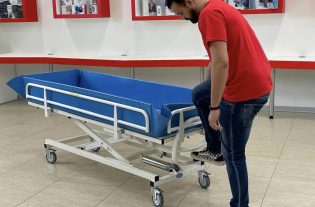Disability and sport: seeing these two words together is perhaps more familiar now, after the last Olympic Games, when a large number of Italian Paralympic athletes made us proud with their medals.
For them, sport marked a turning point, a chance to face a challenge, to view their disability as a strength and find new incentives every day, up to the point of realising world sports’ greatest achievement.
But what is happening in the Italian provinces? What is the relationship between motor disability and sport for very young children?
The person asking himself this question was Costantino Perna, businessman and founder of Lab 3.11, a company that designs, develops and manufactures sports aids for the disabled.
Costantino, tell us how you came up with the idea of developing aids for the disabled specifically for sports?
The idea was conceived in room 11, on the third floor of the Turin Spinal Unit. That is why the brand is called “Lab 3.11” . I have personal experience of the day-to-day difficulties caused by disability, so I decided to create products that would allow disabled people to release their energy and face new challenges, starting with sports.
A revolutionary new product has been created at Lab 3.11. Tell us about Energy?
Energy is the result of the desire to allow all children with motor disabilities to play sports. For a disabled child, being excluded from PE from the very first day of primary school, as often happens even now, means being excluded from an activity that is essential for their growth. I believe that sport is an indispensable opportunity for a disabled child, a chance to face a challenge, to socialise and to starting learning independence. Energy offers the means to achieve this. It is a wheelchair that develops with the child and allows him or her to perform physical activities.
Have you proposed this new product in schools?
Yes, I have proposed introducing an Energy wheelchair into classrooms where a disabled child is present. The school I contacted was the Sofonisba Anguissola Institute in Cremona, which decided this was the right product for a school project with Fondazione Mondo Digitale. The project was entered in the most recent edition of the Global Junior Challenge, an international competition for innovative ideas and technologies, and finished among the finalists.
The school’s head teacher, Flavio Arpini, then took the idea to the Board of Education and this led to a protocol of intent between the Cremona Territorial Education Office, the “Sofonisba Anguissola” Human, Economic and Social Sciences High School, the “Straffa” Institute of Higher Education in Cremona and the Territorial Support Centre of the province of Cremona.
This has all led to Energy currently being used in three classes at two institutes.
How is the project going?
The project has exceeded all expectations. The disabled youngsters have started playing sports and two of them have even started participating in sports courses for the able-bodied outside the school walls. The wheelchair has allowed them to discover sports and cultivate a new passion.
But I have to admit that this is perhaps not the greatest achievement of Energy…
What is?
There is an aspect of school organisation of which I was unaware: disabled children do not have recess, meaning they stay in the classroom and the teacher often asks their classmates to take it in turns to keep them company. This led us to provide the classes with another two wheelchairs.
And what happened?
The children fall over themselves to get the wheelchairs and play with the disabled child on the same terms. The additional wheelchairs, which are high-performance and totally safe, have boosted inclusion outside of sports as well.










